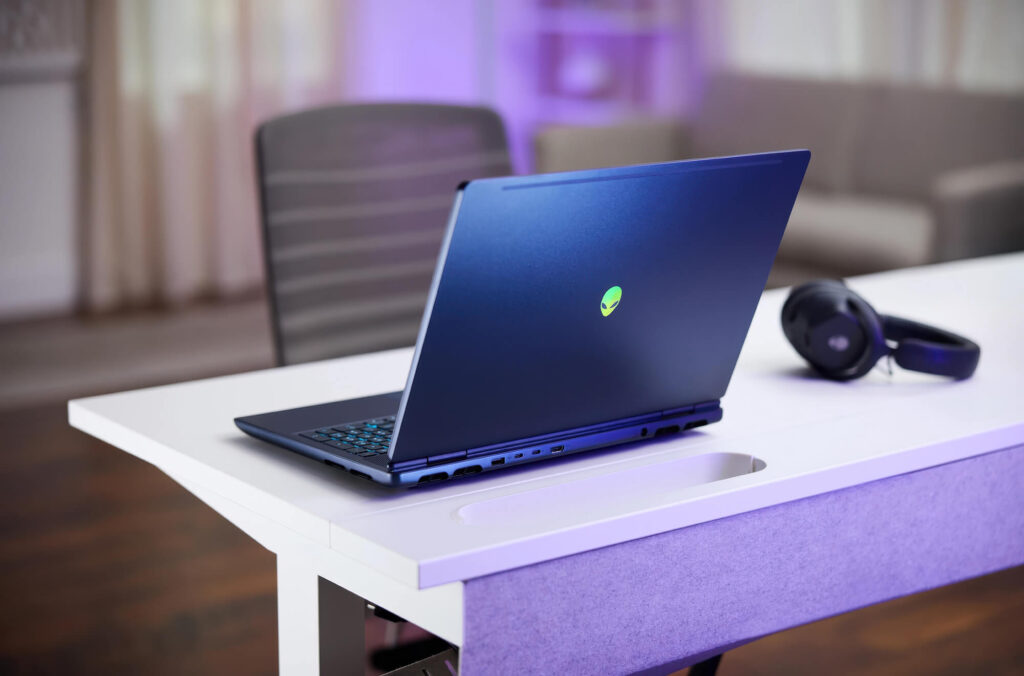When you talk about gaming laptops, what qualifies as “affordable?” This is a strange question, considering esports professionals and MMO gamers know the difference between “playable” and “performance-ready” systems. Most of us are familiar with the drill; if you want discrete graphics, a high refresh rate, and high-end cooling when rendering a raid boss fight, you’re probably not looking in the bargain bin.
This is where Alienware’s new Aurora 16 lineup lands: not quite entry level, definitely not budget, but also not in the face-melting “Area 51” territory either. It’s a balancing act, and depending on your needs – and your wallet – it just may work.
Dell has always been in the gamer flex corset with their Alienware brand. The look, the glow, the reputation – it’s eye candy. With the Aurora 16, however, they’ve toned it down just enough to hook more serious, budget conscious players. But don’t worry, you’re still getting that signature design language – now with a subtle “I show up to compete, not just to look cool” twist.”
Updates to Dell’s design now replace the older, more awkward shelf hinges with what they call a “cryo-chamber,” which is little more than a rebranded airflow system. The airflow intake draws air from three different locations and exhausts from the back, where the keyboard and chassis tilts naturally. You could say it’s like the machine trying to help you game harder without causing a fuss. Clever.
That’s it for the gloss, let’s get under the hood where the action is.
The base model of the Aurora 16 packs a Core 7 240H CPU together with an RTX 4050 GPU. This is a solid combination that should be able to reasonably run most modern titles from 2023 on medium-to-high standards. The RAM sits at 16GB, standard for nowadays and paired with a generous 1TB SSD which is honestly the bare minimum in 2025. At least there is a 1440p 120Hz panel available, although it does add to the overall appeal of the machine without being ultra-premium or basic.
In the ports department, you have the usual two USB-A, USB-C, HDMI, and even Ethernet, although Dell puzzlingly placed the latter on the side instead of the back. Desk users won’t appreciate that. The base battery is… well, let’s be honest, it would not last you a grind session so long as you’re not countdown timers or just browsing forums.
And the cost? It starts from $1,149. While not the lowest price ever, it sits moderately in the ecosystem of devoted gaming rigs.
If you fall into the group who prefers maxing every setting, and blasting the fans to the maximum, however, there is the Aurora 16X.
Things are getting serious here. The 16X features a Core Ultra 9 275HX with 24 cores, RTX 5060 GPU, 32GB of RAM, a 2TB SSD, and the RTX 5060 GPU—practically everything from the base model is upgraded. The screen? Freshly upgraded to 240Hz and 500 nits, which is ideal for those late night sessions and competitive scrims where frames matter.
The battery adds up to 96Wh (upgradable on non-X models) and the full RGB keyboard and facial recognition IR camera adds hilarious touches to the device experience—who says no to feeling like a cyber spy?
But this upgrade bumps the starting price to $1,949.99. Before any personal tweaks, it is tough to swallow the idea of nearly 2k. Not alterable cash, that is for sure.
Here’s the deal: both the Aurora 16 and 16X can be specced up even further. Want to game with an RTX 5070? Go for it. Need 64GB of RAM for streaming, gaming, and maybe a bit of Blender on the side? That’s available too. Storage of up to 4TB? Sure, if you’ve got the coin.
And that’s kind of the rub. While Alienware has a more approachable price point, you’re paying a premium for the brand and build quality. It’s the classic gamer’s dilemma, do you chase performance, or do you chase value?
Let’s talk MMO, specifically—because this crowd doesn’t just load up for 30-minute deathmatch sessions. We’re talking all-day raids, deep modding, and alt-tabbing, with Discord and countless other browsers and overlays running in the background.
For that kind of work, the basic Aurora 16 model may be on the edge. It can run Final Fantasy XIV, Guild Wars 2, or ESO without issues, but you may encounter some limits with heavy multitasking or when future expansions are added and need more resources. The 16X, on the other hand, feels like a long-term investment. Additional RAM, improved cooling system, and GPU that won’t require upgrading anytime soon mean it was designed for long gaming sessions where performance drops are not tolerated.




